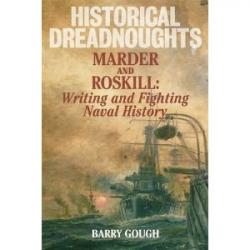Historical Dreadnoughts: Marder, Roskill and the Battles for Naval History

By Barry Gough, Seaforth, Barnsley, 2010, 366 pages including index, ISBN: 978 1 84832 0772, £30
Review by Ian Nish
Professor Gough’s Historical Dreadnoughts is biography rather than autobiography. It is a joint biography of two historians of the Royal Navy in the twentieth century. While much of the book is taken up with disputes between these two historical giants – historians have been known to disagree! –it contains much of relevance to the story of the Asia-Pacific war.
First, the American historian, Arthur Marder, who published his first book entitled The Anatomy of British Sea Power in 1939 to great acclaim. Forsaking history, he decided in June 1942 to undertake a year of intensive study of the Japanese language at Harvard. He left having acquired “a swell foundation in Japanese and a firmer grip on the Far East (p. 31),” thanks to coaching from Edwin Reischauer. After failing to enlist in the US navy, he applied for entry as an officer in the Royal Navy but incredibly received the reply in 1943 that “no suitable vacancies have arisen in which your qualifications could be utilized.” In due course he took up teaching appointments in Hawaii and California, becoming all the while renowned for a cluster of books on recent British naval history. Admiral Lord Louis Mountbatten suggested that he should explore the interaction of the Imperial Japanese Navy (IJN) with the Royal Navy in peace and war. Marder was attracted by the idea and travelled to Japan in 1961 but turned aside from the project because of the paucity of naval archives. He returned in 1975, undertook some archival research and conducted interviews with former naval officers. The fruits of his work came out in volume I of Old Friends, New Enemies, 1936-41, published after his death in 1980. Two of his former graduate students completed his overall project by taking the story to 1945 in volume II. Marder’s conclusion was that the failure of the Japanese navy in the war could not be attributed to being overwhelmed by superior technology or the greater ship-numbers on the Allied side; Japan’s naval leaders relied too much on their moral and spiritual convictions and suffered from over-confidence.
The second biographee, Captain Stephen Roskill, came from a different route in his approach to Japan. A professional sailor, he rose through the ranks and served in the Royal New Zealand Navy from 1941, acting as executive officer of the cruiser, HMNZS Leander. In this capacity he fought the IJN in one of the important battles of the war in the south Pacific, Kolombangara in the Solomons (July 1943). When he left the navy after the war, he was appointed as the official historian of the Royal Navy and among countless other works wrote three volumes on The War at Sea, 1939-45 (HMSO, 1954-61), the last volume covering the Pacific naval war.
Both writers had to address Britain’s problem in using her over-stretched naval resources to defend her empire against Japan and to assess the decision to send the Prince of Wales and Repulse to the east, their sinking by Japanese aircraft and the fall of Singapore (1942). They were both critical of many aspects of British decision-making. Roskill placed much of the blame on Admiral Sir Dudley Pound, the ailing First Sea Lord, and his interventionist overlord, Prime Minister Winston Churchill. Gough follows Marder in believing that “Churchill’s obsession for offensive action on political grounds might be countered by Pound’s professional pragmatism (p. 250).” But Roskill felt that Marder exaggerated Pound’s ability to stand up to Churchill. Each view has its supporters even today. Such are the lingering controversies over issues central to our history! Though much in this book falls in the category of global history, Professor Gough has skilfully drawn our attention to much in the writings of these gladiatorial historians which has ongoing relevance.
This book along with my other related review (Burma to Japan with Azad Hind: A war memoir) cover three careers with links to Japan over the brief war years. One a poignant personal narrative, the other a scholarly retrospective assessment. Readers with an interest in Anglo-Japanese relations will learn much from the unfamiliar stories and the strong characters involved.

